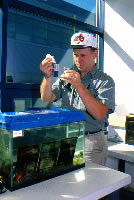
![]()
 |
| Algae water sample test by Dr. C. Linkous. (Photo: S. Spencer) |
|---|
Weathering of painted surfaces is a continuing and costly problem. One aspect of the weathering process is the attachment of microorganisms such as fungi and algae that can chemically attack a paint formulation or otherwise cause the surface to become aesthetically unacceptable and eventually unusable. To solve this problem, the paint industry commonly includes antifungal agents (biocides) in their paint formulations. The biocide is absorbed by the microorganism attempting to attach to the surface, resulting in cell death. This process is effective as long as there is biocide available to be leached out of the paint layer. However, the biocides — commonly metallic salts — are leached out of the paint surface with successive rainfalls and time. Once the biocides are depleted, the surface is no longer protected.
The other aspect of the paint industry approach is that the unabsorbed leachate ultimately enters the surrounding waterways. This process is particularly severe in marinas and harbors where the hulls of watercraft have been painted with formulations to prevent not only microorganism but also barnacle attachment. The chief anti-biofoulant component of these coatings is copper. Most bottom paints contain large amounts (sometimes as much as 75%) of cuprous oxide. These paints unavoidably leach a steady trickle of copper species into the surrounding waters. The purpose of this research is to replace copper and other metallic salt biocidal agents in paints with nondissolving photocatalytic oxidants.
FSEC researchers have developed a process that uses photocatalytic paint formulations to resist the accumulation and growth of microorganisms. This process is an environmentally friendly approach that can replace paints that are intentionally laden with leachable copper and other heavy metals that are currently utilized to perform the antifungel function. The ability of photocatalytic coatings to protect submerged surfaces from fresh water algae has already been demonstrated in FSEC's laboratory, and the possibility of expanding this effort to examine photocatalytic protection of open-air painted surfaces such as walls and rooftops is being investigated. See photoelectrochemical control process and patents for technical details.
